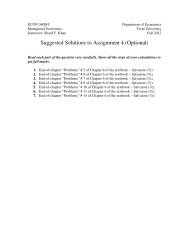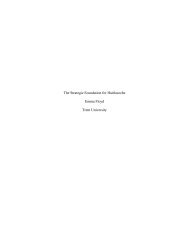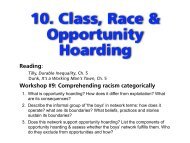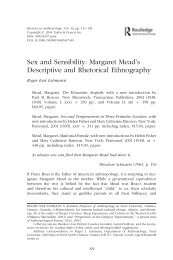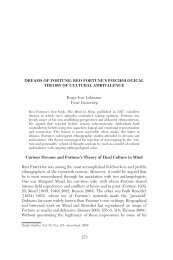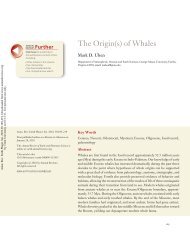morphological support for a close relationship between hippos and ...
morphological support for a close relationship between hippos and ...
morphological support for a close relationship between hippos and ...
You also want an ePaper? Increase the reach of your titles
YUMPU automatically turns print PDFs into web optimized ePapers that Google loves.
MORPHOLOGICAL SUPPORT FOR A CLOSE RELATIONSHIP BETWEEN<br />
HIPPOS AND WHALES<br />
Author(s): JONATHAN H. GEISLER <strong>and</strong> MARK D. UHEN<br />
Source: Journal of Vertebrate Paleontology, 23(4):991-996. 2003.<br />
Published By: The Society of Vertebrate Paleontology<br />
DOI: 10.1671/32<br />
URL: http://www.bioone.org/doi/full/10.1671/32<br />
BioOne (www.bioone.org) is an electronic aggregator of bioscience research content, <strong>and</strong> the online home to over<br />
160 journals <strong>and</strong> books published by not-<strong>for</strong>-profit societies, associations, museums, institutions, <strong>and</strong> presses.<br />
Your use of this PDF, the BioOne Web site, <strong>and</strong> all posted <strong>and</strong> associated content indicates your acceptance of<br />
BioOne’s Terms of Use, available at www.bioone.org/page/terms_of_use.<br />
Usage of BioOne content is strictly limited to personal, educational, <strong>and</strong> non-commercial use. Commercial inquiries<br />
or rights <strong>and</strong> permissions requests should be directed to the individual publisher as copyright holder.<br />
BioOne sees sustainable scholarly publishing as an inherently collaborative enterprise connecting authors, nonprofit publishers, academic institutions, research<br />
libraries, <strong>and</strong> research funders in the common goal of maximizing access to critical research.
Journal of Vertebrate Paleontology 23(4):991–996, December 2003<br />
� 2003 by the Society of Vertebrate Paleontology<br />
991<br />
RAPID COMMUNICATION<br />
MORPHOLOGICAL SUPPORT FOR A CLOSE RELATIONSHIP BETWEEN<br />
HIPPOS AND WHALES<br />
JONATHAN H. GEISLER 1 <strong>and</strong> MARK D. UHEN 2<br />
1 Department Geology/Geography <strong>and</strong> Georgia Southern Museum, Georgia Southern University, Statesboro, Georgia<br />
30460-8149, geislerj@georgiasouthern.edu;<br />
2 Cranbrook Institute of Science, 39221 Woodward Avenue, P.O. Box 801, Bloomfield Hills, Michigan 48303-0801,<br />
uhen@umich.edu<br />
Recent discoveries of the ankles of fossil whales, reported<br />
by Gingerich et al. (2001) <strong>and</strong> Thewissen et al. (2001b), corroborated<br />
the molecular hypothesis that Cetacea (whales, dolphins,<br />
<strong>and</strong> porpoises) are <strong>close</strong>ly related to artiodactyls (evenhoofed<br />
mammals including hippopotami, pigs, deer, <strong>and</strong> camels);<br />
however, major points of disagreement remain. A morphology-based<br />
study incorporating some of these new data<br />
(Thewissen et al., 2001b) <strong>support</strong>ed the exclusion of Cetacea<br />
from the clade of living artiodactyls. In contrast, a vast amount<br />
of molecular data <strong>support</strong> placement of Cetacea within Artiodactyla,<br />
as <strong>close</strong> relatives to Hippopotamidae (Gatesy et al.,<br />
1996, 1999; Montgelard et al., 1997; Shimamura et al., 1997,<br />
1999; Nikaido et al., 2001). Here we report that <strong>morphological</strong><br />
data from extinct <strong>and</strong> extant taxa <strong>support</strong> placement of Cetacea<br />
within Artiodactyla as the <strong>close</strong>st relatives of Hippopotamidae<br />
(Fig. 1B) <strong>and</strong> indicate that molecular <strong>and</strong> <strong>morphological</strong> evidence<br />
<strong>for</strong> the phylogeny of these taxa are now much more congruent<br />
than previously thought.<br />
MATERIALS AND METHODS<br />
Our result is based on a cladistic analysis of a modified version<br />
of the character/taxon matrix of Geisler (2001a). The present<br />
matrix incorporates new in<strong>for</strong>mation on the early cetaceans<br />
Artiocetus, Rodhocetus (Gingerich et al., 2001), <strong>and</strong> Pakicetus<br />
(Thewissen et al., 2001b); includes some changes in the scoring<br />
of Basilosaurus; adds the artiodactyls Amphirhagatherium weigelti<br />
(Heller, 1934; Erfurt, 2000; Hooker <strong>and</strong> Thomas, 2001)<br />
<strong>and</strong> Raoellidae (Kumar <strong>and</strong> Sahni, 1985; Thewissen et al.,<br />
2001b); includes the mesonychid Ankalagon (AMNH-VP 776,<br />
777, 2454; O’Leary et al., 2000); adds seven characters from<br />
Thewissen et al. (2001b), <strong>and</strong> consists of 195 characters scored<br />
<strong>for</strong> 69 mammalian taxa. The matrix <strong>and</strong> character list are available<br />
on the internet at http://www.vertpaleo.org/jvp/JVPcontents.html.<br />
Of the 195 characters, 121 are binary, 14 are unordered<br />
multistate characters, <strong>and</strong> 60 are ordered multistate characters.<br />
Although we do not claim to have included every published<br />
character relevant to cetartiodactyl phylogeny, we note<br />
that this matrix has substantially more taxa <strong>and</strong> more <strong>morphological</strong><br />
characters than previous phylogenetic analyses (e.g.,<br />
Geisler <strong>and</strong> Luo, 1998; O’Leary, 1998, 2001; Luo <strong>and</strong> Gingerich,<br />
1999; O’Leary <strong>and</strong> Geisler, 1999; O’Leary <strong>and</strong> Uhen,<br />
1999; Thewissen et al., 2001b).<br />
The computer program NONA 1.9 (Goloboff, 1994) was<br />
used to find most parsimonious trees. An initial search was<br />
conducted using two comm<strong>and</strong>s: mult*100; hold/10, which invoke<br />
100 iterations of TBR (tree bisection <strong>and</strong> reconnection)<br />
branch swapping <strong>and</strong> save only 10 trees per iteration. The most<br />
parsimonious tree from the initial search was used as a starting<br />
tree <strong>for</strong> 1,000 iterations of the parsimony ratchet (Nixon, 1999),<br />
which was implemented with the comm<strong>and</strong> nix*1000. Bremer<br />
<strong>support</strong> values were calculated using the programs PAUP 3.1.1<br />
(Swof<strong>for</strong>d, 1993) <strong>and</strong> TreeRot (Sorenson, 1996), with modifications<br />
to the TreeRot comm<strong>and</strong>s file as described in Geisler<br />
(2001a). Lists of unequivocal synapomorphies <strong>for</strong> each node<br />
were compiled using the apo/ comm<strong>and</strong> in NONA 1.9. Where<br />
we describe synapomorphies <strong>support</strong>ed by our study, we cite<br />
previous studies that have reached the same conclusion.<br />
Institutional Abbreviations AMNH, American Museum<br />
of Natural History, Departments of Mammalogy <strong>and</strong> Vertebrate<br />
Paleontology (New York); GSM, Georgia Southern Museum,<br />
Vertebrate Collection (Statesboro, Georgia); IVPP, Institute of<br />
Vertebrate Paleontology <strong>and</strong> Paleoanthropology, Chinese Academy<br />
of Sciences (Beijing, China).<br />
RESULTS<br />
A total of 45 most parsimonious trees of 1,513 steps in length<br />
were found (within-taxon polymorphism was not counted as<br />
extra steps). All most parsimonious trees have Cetacea deeply<br />
nested within Artiodactyla as the sister-group to Hippopotamidae<br />
(Fig. 1B), like molecular studies <strong>and</strong> unlike the most recent<br />
<strong>morphological</strong>-based analysis (Thewissen et al., 2001b) (Fig.<br />
1A). The novel <strong>morphological</strong> result reported here is primarily<br />
attributed to recently described cetacean fossils (Gingerich et<br />
al., 2001; Thewissen et al., 2001b), because a study with similar<br />
characters <strong>and</strong> taxa, but without the new ankle data, <strong>support</strong>ed<br />
the exclusion of Cetacea from Artiodactyla <strong>and</strong> a <strong>close</strong> <strong>relationship</strong><br />
<strong>between</strong> Cetacea <strong>and</strong> Mesonychidae (Geisler, 2001a),<br />
an extinct group of hoofed mammals. We concur with recent<br />
authors (Gingerich et al., 2001; Thewissen et al., 2001b) that a<br />
suite of characters in the ankles of early whales <strong>support</strong>s a clade<br />
comprised of Cetacea <strong>and</strong> Artiodactyla but not mesonychids.<br />
The sister-group to the hippo/whale clade varies among the<br />
most parsimonious trees; in 36 trees the sister-group is a clade<br />
of sui<strong>for</strong>m artiodactyls including Suina (pigs <strong>and</strong> peccaries),<br />
Entelodontidae, <strong>and</strong> Anthracotheriidae (represented by Elomeryx);<br />
<strong>and</strong> in the remaining nine trees it is Raoellidae. The latter<br />
trees are interesting because like cetaceans, raoellids possess a<br />
P4 paracone that is much higher than those of the succeeding<br />
molars. Like pakicetids (Thewissen <strong>and</strong> Hussain, 1998) <strong>and</strong> the<br />
protocetid Artiocetus (Gingerich et al., 2001), raoellids such as<br />
Kunmunella kalakotensis (Kumar <strong>and</strong> Shani, 1985) also have a<br />
single-rooted P1. Intriguingly, raoellid fossils are abundant in<br />
the same Asian sites that produce pakicetids (Thewissen et al.,<br />
2001a). Un<strong>for</strong>tunately, the non-dental anatomy of raoellids is<br />
undescribed. Discoveries of new raoellid fossils would not only<br />
test the hypothesis that they are <strong>close</strong>ly related to <strong>hippos</strong> <strong>and</strong>
992 JOURNAL OF VERTEBRATE PALEONTOLOGY, VOL. 23, NO. 4, 2003<br />
FIGURE 1. A comparison of the strict consensus tree of Thewissen et al. (2001b) (A) <strong>and</strong> the strict consensus tree <strong>for</strong> the present study (B).<br />
Note that in the consensus of Thewissen et al. (2001b) the Cetacea are not inside the clade of extant artiodactyls, <strong>and</strong> the hippopotamus is not<br />
<strong>close</strong>ly related to whales. In contrast, the <strong>morphological</strong> data analyzed in this study <strong>support</strong> the inclusion of Cetacea within Artiodactyla as the<br />
sister-group to Hippopotamidae, as suggested by numerous molecular studies (e.g., Gatesy et al., 1999). To facilitate comparison <strong>and</strong> to highlight<br />
key features, some taxa have been collapsed into higher-level groups. In cases where a higher-level taxon includes three or more taxa, parentheses<br />
are used to describe the phylogeny in the strict consensus of the present study: (all taxa with ‘‘*’’ are in the current study only): Cameloidea �<br />
(Eotylops* (Poebrotherium (Llama*, Camelus*))); Entelodontidae (Archaeotherium); Hapalodectes � (H. hetangensis*, H. leptognathus*); Mesonychidae<br />
� (Dissacus praenuntius*, Dissacus navajovius*, Mongolian Dissacus* (Ankalagon (Sinonyx (Pachyaena gigantea*, Pachyaena<br />
ossifraga*, (Mesonyx, Harpagolestes, Synoplotherium))))); Mysticeti � (Balaenoptera); Odontoceti � (Physeter (Tursiops, Delphinapterus); Oreodontoidea<br />
� (Agriochoerus, Merycoidodon*); Perissodactyla � ((Equus*, Mesohippus*) (Heptodon*, Hyracotherium*)); Phenacodontidae �<br />
(Meniscotherium, Phenacodus); Protoceratidae � (Leptoreodon* (Heteromeryx*, Protoceras*)); Ruminantia � (Hypertragulus* (Leptomeryx*<br />
(Tragulus (Bos* (Odocoileus*, Ovis*))))); Suina � (Perchoerus* (Sus, Tayassu*)); <strong>and</strong> Xiphodontoidea � (Xiphodon*, Amphimeryx*). In the
GEISLER AND UHEN—WHALES AND HIPPOS CLOSELY RELATED<br />
FIGURE 2. Posterior view of the left squamosal, petrosal, <strong>and</strong> tympanic<br />
bulla of a juvenile Hippopotamus amphibius (AMNH 130247).<br />
Lateral is to the left, dorsal is to the top, <strong>and</strong> the occipital bones have<br />
been removed. Note the elongate mastoid process of the petrosal, a trait<br />
also seen in cetaceans. Abbreviations: VII, stylomastoid <strong>for</strong>amen <strong>for</strong><br />
the facial nerve (cranial nerve VII); mp, mastoid process of the petrosal;<br />
pet, petrosal; sq, squamosal; sqs, sutural surface on the squamosal <strong>for</strong><br />
the exoccipital; tyb, ectotympanic bulla.<br />
whales but would also help resolve the ambiguity in the optimization<br />
of several characters across higher-level cetartiodactyl<br />
clades.<br />
Only two of the characters that <strong>support</strong> a sister-group <strong>relationship</strong><br />
<strong>between</strong> Cetacea <strong>and</strong> Hippopotamidae are unequivocal<br />
synapomorphies: absence of paraconules on upper molars <strong>and</strong><br />
absence of crest <strong>between</strong> the hypoconid <strong>and</strong> entoconid (i.e.,<br />
hypolophid) on lower molars. Several other characters are<br />
equivocal synapomorphies of the hippo/whale clade because<br />
they cannot be scored in raoellids, <strong>and</strong> thus could be a synapomorphy<br />
of Raoellidae � Cetacea � Hippopotamidae in nine<br />
of the most parsimonious trees. These characters include salient<br />
features such as the near absence of hair <strong>and</strong> the loss of sebaceous<br />
gl<strong>and</strong>s (Gatesy et al., 1996), as well as previously unrecognized<br />
features such as a low dentary condyle, wide fifth<br />
metatarsal, nasals that terminate <strong>between</strong> the orbits, <strong>and</strong> elongate<br />
mastoid process of the petrosal. In adults of Hippopotamus<br />
amphibious the mastoid process appears to be absent; however,<br />
it has only fused to the squamosal. An elongate, anteroposteriorly-compressed<br />
mastoid process is visible in skulls of juvenile<br />
specimens (Fig. 2). Interestingly, mesonychids also have<br />
an elongate mastoid process <strong>and</strong> a posterior position of the nasals.<br />
Although these similarities are most-parsimoniously interpreted<br />
as convergent on the shortest trees <strong>for</strong> this study, it is<br />
clear that <strong>morphological</strong> data do not universally <strong>support</strong> a Hippopotamidae<br />
<strong>and</strong> Cetacea clade. Further evidence <strong>for</strong> disagreement<br />
<strong>between</strong> some <strong>morphological</strong> characters is the low Bremer<br />
<strong>support</strong> <strong>for</strong> clades that render Artiodactyla paraphyletic: Cetar-<br />
←<br />
present study, coding <strong>for</strong> Cebochoeridae is based on Cebochoerus only, while Thewissen et al. (2001b) include data from Gervachoerus. Similarly,<br />
Thewissen et al. (2001b) created a composite of Amphirhagatherium (Anthracobunodon) <strong>and</strong> Haplobunodon, while we used Amphirhagatherium<br />
weigelti only. For specifics of the phylogenies within Mesonychidae in strict consensus A, readers are referred to Thewissen et al. (2001b). The<br />
simplified consensus of the current study (B) includes clades common to all 45 most-parsimonious trees, each 1,513 steps in length.<br />
993<br />
tiodactyla has a Bremer <strong>support</strong> of 3; the Cetacea <strong>and</strong> Hippopotamidae<br />
clade has a Bremer <strong>support</strong> of 2.<br />
In all most-parsimonious trees, many ‘‘sui<strong>for</strong>m’’ artiodactyls<br />
(e.g., anthracotheres, entelodontids, suids, tayassuids) are <strong>close</strong>ly<br />
related to the Hippopotamidae <strong>and</strong> Cetacea clade. Even<br />
though the exact phylogenetic arrangement of the ‘‘sui<strong>for</strong>m’’<br />
artiodactyls varies among our shortest trees, their proximity to<br />
cetaceans <strong>and</strong> hippopotamids is <strong>support</strong>ed by an enlarged facial<br />
portion of the lacrimal. In Hippopotamus <strong>and</strong> early whales such<br />
as Georgiacetus (Hulbert et al., 1998) <strong>and</strong> Remingtonocetus<br />
(Kumar <strong>and</strong> Sahni, 1986:fig. 4) the distance <strong>between</strong> the anteriormost<br />
point of the lacrimal <strong>and</strong> the anterior edge of the orbit<br />
is greater than the anteroposterior diameter of the orbit (Fig.<br />
3A, B). By contrast, mesonychids such as Sinonyx (Zhou et al.,<br />
1995) have a much smaller exposure of the lacrimal on the face<br />
(Fig. 1C). A large lacrimal also occurs on the face of extant<br />
ruminants (e.g., Odocoileus, Ovis, Tragulus); however, this similarity<br />
is interpreted as convergent because the basal ruminants<br />
Hypertragulus (e.g., AMNH 53802, 1341) <strong>and</strong> Leptomeryx<br />
(e.g., AMNH 11870) have a small facial portion of the lacrimal.<br />
Although our <strong>morphological</strong> data <strong>and</strong> molecules agree on a<br />
sister-group <strong>relationship</strong> <strong>between</strong> Hippopotamidae <strong>and</strong> Cetacea,<br />
molecular data do not <strong>support</strong> a <strong>close</strong> <strong>relationship</strong> <strong>between</strong> the<br />
cetacean/hippopotamid clade <strong>and</strong> ‘‘sui<strong>for</strong>m’’ artiodactyls. Instead,<br />
vastly different molecular characters including nucleotide<br />
sequences (Gatesy et al., 1996, 1999; Montgelard et al., 1997),<br />
SINEs (short interspersed nuclear elements) (Shimamura et al.,<br />
1997, 1999; Nikaido et al., 1999), <strong>and</strong> multiple base-pair deletions<br />
(Gatesy et al., 1996; Geisler, 2001b) <strong>support</strong> a clade<br />
including Ruminantia (deer, cows, antelope), Hippopotamidae,<br />
<strong>and</strong> Cetacea, but excluding Suina. As in previous studies, the<br />
<strong>morphological</strong> data analyzed here continue to <strong>support</strong> monophyly<br />
of Neoselenodontia, which includes the sister-groups<br />
Ruminantia <strong>and</strong> Cameloidea. Neoselenodontia is <strong>support</strong>ed by<br />
several characters, including small supraspinatus fossa of the<br />
scapula, tibia <strong>and</strong> fibula fused at proximal ends, <strong>and</strong> middle<br />
portions of 2nd <strong>and</strong> 5th metatarsals absent (Geisler, 2001a).<br />
Even so, the degree to which the <strong>morphological</strong> data of the<br />
present study contradict Ruminantia � Hippopotamidae � Cetacea<br />
is much less than previously published matrices. According<br />
to the matrix of Geisler (2001a), this clade had a Bremer<br />
<strong>support</strong> of �23, while in the present study its Bremer <strong>support</strong><br />
has increased by 9 steps to �14.<br />
Unlike Geisler (2001a) but like many previous studies (e.g.,<br />
Geisler <strong>and</strong> Luo, 1998; O’Leary, 1998; O’Leary <strong>and</strong> Geisler,<br />
1999), the present study <strong>support</strong>s monophyly of Mesonychia<br />
(sensu O’Leary, 1998) <strong>and</strong> Mesonychidae. Mesonychia has a<br />
Bremer <strong>support</strong> of one <strong>and</strong> is diagnosed by seven unequivocal<br />
synapomorphies: well developed parastyle on M1 (O’Leary <strong>and</strong><br />
Geisler, 1999), M2 metacone half the size of paracone, m3 hypoconulid<br />
absent, molar paraconules absent, paraconid directly<br />
anterior to protoconid (O’Leary, 1998), protoconid nearly twice<br />
the height of talonid, <strong>and</strong> narrow talonid basin. Mesonychidae<br />
has a Bremer <strong>support</strong> of four <strong>and</strong> is <strong>support</strong>ed by three unequivocal<br />
synapomorphies: postglenoid <strong>for</strong>amen small or absent<br />
(Luo <strong>and</strong> Gingerich, 1999; O’Leary <strong>and</strong> Geisler, 1999),<br />
<strong>for</strong>amen ovale anterior to glenoid fossa (O’Leary <strong>and</strong> Geisler,<br />
1999), <strong>and</strong> hypocone <strong>and</strong> metaconule absent on upper molars.<br />
Considering the paraphyly of Mesonychidae in the trees of<br />
Geisler (2001a), it appears that the monophyly of Mesonychi-
994 JOURNAL OF VERTEBRATE PALEONTOLOGY, VOL. 23, NO. 4, 2003<br />
FIGURE 3. Comparison of the lacrimals in a hippopotamus, a mesonychid, <strong>and</strong> a primitive cetacean. A, Hippopotamus amphibious (AMNH<br />
15898), right side of skull in anterolateral, <strong>and</strong> slightly dorsal, view; B, the Eocene cetacean Georgiacetus vogtlensis (GSM 350), skull in right<br />
lateral view; C, the mesonychid Sinonyx jiashanensis (IVPP V10760), skull in right lateral view, but image reversed to facilitate comparison.<br />
Note the enlarged facial portion of the lacrimal in Hippopotamus <strong>and</strong> Georgiacetus, but not Sinonyx. Scale bar in each equals 5 cm. See Materials<br />
<strong>and</strong> Methods <strong>for</strong> institutional abbreviations.<br />
dae is contingent upon placing Cetacea within the clade of extant<br />
artiodactyls.<br />
Previously described dental/masticatory characters that <strong>support</strong><br />
a <strong>close</strong> <strong>relationship</strong> <strong>between</strong> mesonychids <strong>and</strong> cetaceans<br />
(Thewissen, 1994; Geisler <strong>and</strong> Luo, 1998; O’Leary, 1998;<br />
O’Leary <strong>and</strong> Geisler, 1999) are optimized as convergent on the<br />
most parsimonious trees of the present study. The claim that<br />
dental characters are convergent is not unprecedented. Three of<br />
the characters that <strong>support</strong> a mesonychid <strong>and</strong> cetacean clade<br />
(i.e., reduction of lower molar metaconids <strong>and</strong> talonid basins;<br />
embrasure pits) also occur in several other distantly related<br />
groups of carnivorous mammals (Muizon <strong>and</strong> Badre, 1997;<br />
Uhen, 1996). We suspect that the convergence in dental characters<br />
<strong>between</strong> cetaceans <strong>and</strong> mesonychians is due to a similarity<br />
in function <strong>and</strong> that several dental characters may not be<br />
independent. For example, the embrasure pits on the maxillae<br />
in early cetaceans, many mesonychians, <strong>and</strong> some carnivorans<br />
accommodate the protoconids of the lower teeth when the<br />
mouth is <strong>close</strong>d. In living carnivorans <strong>and</strong> basilosaurid cetaceans,<br />
the embrasure pits <strong>for</strong>m in direct response to the approximation<br />
of the teeth <strong>and</strong> the bones of the palate <strong>and</strong> jaw<br />
during chewing (Uhen, 1996). There<strong>for</strong>e, embrasure pits <strong>and</strong><br />
the height of the protoconid of the lower molars may not be<br />
evolving independently. The hypothesis that other dental character<br />
states (e.g., absence of molar metaconids, absence of paraconules<br />
<strong>and</strong> metaconules) are interdependent is <strong>support</strong>ed by<br />
statistical studies that show them to be correlated among artiodactyls,<br />
cetaceans, <strong>and</strong> mesonychians (Naylor <strong>and</strong> Adams,<br />
2001; Geisler, 2001b). Even so, the correlation is not perfect,<br />
indicating that a limited degree of independence remains <strong>and</strong><br />
that dental characters should remain in phylogenetic analyses<br />
as separate characters.<br />
The topology common to all our most parsimonious trees is<br />
relatively robust to the exclusion of some anatomical characters.<br />
Like O’Leary <strong>and</strong> Geisler (1999) <strong>and</strong> Geisler (2001a), but unlike<br />
Thewissen et al. (2001b), we included soft-tissue <strong>morphological</strong><br />
characters (e.g., absence of hair, absence of sebaceous<br />
gl<strong>and</strong>s). Although Thewissen et al. (2001b) did not explain why<br />
they chose to exclude these features, their reason may be the<br />
widely held view that the loss of hair <strong>and</strong> sebaceous gl<strong>and</strong>s is<br />
prone to convergence <strong>and</strong> thus unreliable (see Luckett <strong>and</strong><br />
Hong, 1998, <strong>and</strong> references therein). Although we think that<br />
homoplasy is best viewed as an a posteriori interpretation <strong>and</strong><br />
not an a priori assumption, we experimented with our matrix<br />
by removing all six soft tissue characters (i.e., characters 181–<br />
186) <strong>and</strong> re-running the phylogenetic analysis. Using the smaller<br />
matrix, we found 297 most-parsimonious trees of 1,505 steps<br />
each. As in our analyses with all characters included, some<br />
most parsimonious trees <strong>support</strong>ed by the osteology-only version<br />
of our matrix had Cetacea within the clade of extant artiodactyls<br />
as the sister-group to Hippopotamidae; however, the remaining<br />
shortest trees had a monophyletic Cetartiodactyla with<br />
Cetacea as the sister-group to a monophyletic Artiodactyla, a<br />
result similar to that found by Thewissen et al. (2001b).<br />
DISCUSSION<br />
It is reasonable to assume that in the cetartiodactyl transition<br />
from a terrestrial to an aquatic habitat, a semi-aquatic existence<br />
was a necessary intermediate step. Hypotheses on how this<br />
transition occurred <strong>and</strong> which taxa were semi-aquatic have relied<br />
on the perceived sister group to Cetacea (Gatesy <strong>and</strong><br />
O’Leary, 2001; O’Leary, 2001). Based on the most-parsimonious<br />
trees <strong>for</strong> our <strong>morphological</strong> data set, we infer that all
GEISLER AND UHEN—WHALES AND HIPPOS CLOSELY RELATED<br />
cetaceans <strong>and</strong> the common ancestor of hippopotamids <strong>and</strong> cetaceans<br />
were at least semi-aquatic. In <strong>support</strong> of this view, hippopotamids<br />
are semi-aquatic, <strong>and</strong> they share with cetaceans<br />
some aquatic adaptations (e.g., loss of sebaceous gl<strong>and</strong>s <strong>and</strong><br />
loss of hair). Our conclusions are contrary to those of Thewissen<br />
et al. (2001b:278) who state that pakicetids were ‘‘no<br />
more amphibious than a tapir.’’ Unlike a recent reconstruction<br />
of Rodhocetus (Gingerich et al., 2001, cover illustration), character<br />
optimizations on our hypotheses of <strong>relationship</strong>s indicate<br />
that the earliest whales had little to no hair.<br />
A <strong>close</strong> <strong>relationship</strong> <strong>between</strong> Hippopotamidae <strong>and</strong> Cetacea<br />
also challenges hypotheses that give feeding behavior a central<br />
role in the initial cetartiodactyl transition from l<strong>and</strong> to water.<br />
Previous authors have suggested that a change to a piscivorous<br />
diet occurred prior to locomotor adaptations in Cetacea (Gaskin,<br />
1985; O’Leary <strong>and</strong> Uhen, 1999), <strong>and</strong> that this dietary switch,<br />
as indicated by a novel <strong>for</strong>m of tooth wear, was ‘‘. . . the impetus<br />
<strong>for</strong> the transition from life on l<strong>and</strong> to life in water <strong>for</strong> this<br />
clade’’ (O’Leary <strong>and</strong> Uhen, 1999:546). In contrast, optimizing<br />
habitat <strong>and</strong> diet onto our trees indicates that the common ancestor<br />
of <strong>hippos</strong> <strong>and</strong> cetaceans was herbivorous <strong>and</strong> spent considerable<br />
time in the water. The carnivory <strong>and</strong> piscivory observed<br />
in many extant cetaceans is then interpreted to have<br />
evolved later. Even so, O’Leary <strong>and</strong> Uhen (1999) may still be<br />
correct in hypothesizing that changes in diet may have been a<br />
distal cause of additional anatomical adaptations (e.g., loss of<br />
ilia/sacrum contact) to an aquatic environment.<br />
Previously, morphologists studying cetartiodactyl phylogeny<br />
cited long-branch attraction, missing data in fossils, <strong>and</strong> character<br />
polarity as potential problems when using molecular data<br />
to test phylogenetic hypotheses (e.g., Luckett <strong>and</strong> Hong, 1998;<br />
O’Leary <strong>and</strong> Geisler, 1999). Recent paleontological discoveries<br />
(Gingerich et al., 2001; Thewissen et al., 2001b) <strong>and</strong> the current<br />
phylogenetic analysis suggest instead that some <strong>morphological</strong><br />
characters were misleading, <strong>and</strong> that anatomists should consider<br />
molecular data to be a reliable source of phylogenetic in<strong>for</strong>mation.<br />
While in the case of whale origins much of the conflict<br />
<strong>between</strong> <strong>morphological</strong> <strong>and</strong> molecular data was resolved by the<br />
discovery of new fossils that brought the <strong>morphological</strong> hypothesis<br />
more in line with the molecular hypothesis, this has<br />
not always been the case. A recent controversy over the position<br />
of the sperm whale (Physeter catodoni; Milinkovitch et al.,<br />
1993) was resolved by the discovery of new gene sequences,<br />
which brought molecular data in line with the <strong>morphological</strong><br />
<strong>and</strong> paleontological data (Nikaido et al., 2001).<br />
Based on studies that appear to show that <strong>morphological</strong> <strong>and</strong><br />
molecular data are at times fallible, we think that morphologists,<br />
paleontologists, <strong>and</strong> molecular biologists should collect<br />
additional data to determine whether or not ruminants are the<br />
sister-group of the Cetacea <strong>and</strong> Hippopotamidae clade. Despite<br />
the enormous amount of data collected so far, much work remains<br />
to be done. For example, although there are studies that<br />
compare the teeth (O’Leary, 1998), basicranium (Luo <strong>and</strong> Gingerich,<br />
1999), <strong>and</strong> vascular <strong>for</strong>amina (Geisler <strong>and</strong> Luo, 1998)<br />
of cetaceans <strong>and</strong> mesonychians, similar studies that compare<br />
whales to hippopotamids <strong>and</strong> other artiodactyls are lacking. In<br />
turn, molecular biologists can test hypotheses of nucleotide homology<br />
by sampling more taxa <strong>and</strong> by sequencing new genes.<br />
Regardless of the data employed, we remain optimistic that new<br />
data will continue to bring <strong>morphological</strong> <strong>and</strong> molecular hypotheses<br />
<strong>for</strong> the origin of whales into congruence, <strong>and</strong> out of<br />
conflict.<br />
ACKNOWLEDGMENTS<br />
We greatly appreciate the help of Mick Ellison <strong>and</strong> Bolortsetseg<br />
Minjin in photographing the hippopotamus skull in Figure<br />
3. Bolortsetseg Minjin also helped code characters 187 <strong>and</strong><br />
995<br />
188 <strong>for</strong> several specimens in the American Museum of Natural<br />
History. Michael Morlo helped with the translation of key passages<br />
in several German papers, which allowed us to incorporate<br />
Amphirhagatherium into our study. Kyle Staulter assisted<br />
with earlier versions of Figure 1. We also thank Philip Gingerich<br />
<strong>for</strong> access to the type specimen of Sinonyx jiashanensis,<br />
Alfred Mead <strong>and</strong> William Wall <strong>for</strong> access to specimens in the<br />
mammalogy <strong>and</strong> fossil vertebrate collections of Georgia College<br />
& State University, <strong>and</strong> David Bohaska <strong>and</strong> Robert Purdy<br />
<strong>for</strong> access to specimens at the United States National Museum.<br />
Glenn Feldake <strong>and</strong> Tony Barthel (Smithsonian National Zoological<br />
Park) provided vital in<strong>for</strong>mation on the feet of extant<br />
species of <strong>hippos</strong>. In particular we thank Mr. Fledake <strong>for</strong> sending<br />
photographs of both species.<br />
LITERATURE CITED<br />
Erfurt, J. 2000. Reconstruction of the skeleton <strong>and</strong> biology of Anthracobunodon<br />
weigelti (Artiodactyla, Mammalia) from the Eocene of<br />
the Geiseltal (Germany). Hallesches Jahrbuch für Geowissenschaften,<br />
B 12:57–141.<br />
Gaskin, D. E. 1985. The Ecology of Whales <strong>and</strong> Dolphins. Heinemann,<br />
Portsmouth, 459 pp.<br />
Gatesy, J., <strong>and</strong> M. A. O’Leary. 2001. Deciphering whale origins with<br />
molecules <strong>and</strong> fossils. Trends in Ecology <strong>and</strong> Evolution 16:562–<br />
570.<br />
———, C. Hayashi, A. Cronin, <strong>and</strong> P. Arct<strong>and</strong>er. 1996. Evidence from<br />
milk casein genes that cetaceans are <strong>close</strong> relatives of hippopotamid<br />
artiodactyls. Molecular Biology <strong>and</strong> Evolution 13:954–963.<br />
———, M. Milinkovitch, V. Waddell, <strong>and</strong> M. Stanhope. 1999. Stability<br />
of cladistic <strong>relationship</strong>s <strong>between</strong> Cetacea <strong>and</strong> higher-level artiodactyl<br />
taxa. Systematic Biology 48:6–20.<br />
Geisler, J. H. 2001a. New <strong>morphological</strong> evidence <strong>for</strong> the phylogeny of<br />
Artiodactyla, Cetacea, <strong>and</strong> Mesonychidae. American Museum Novitates<br />
3344:1–53.<br />
——— 2001b. Morphological <strong>and</strong> molecular evidence <strong>for</strong> the phylogeny<br />
of Cetacea <strong>and</strong> Artiodactyla: explaining incongruence <strong>between</strong><br />
types of data. Ph.D. dissertation, Columbia University, New York,<br />
475 pp.<br />
———, <strong>and</strong> Z. Luo. 1998. Relationships of Cetacea to terrestrial ungulates<br />
<strong>and</strong> the evolution of cranial vasculature in Cete; pp. 163–<br />
212 in J. G. M. Thewissen (ed.), The Emergence of Whales. Plenum,<br />
New York.<br />
Gingerich, P. D., M. u. Haq, I. S. Zalmout, I. H. Khan, <strong>and</strong> M. S.<br />
Malakani. 2001. Origin of whales from early artiodactyls: h<strong>and</strong>s<br />
<strong>and</strong> feet of Eocene Protocetidae from Pakistan. Science 293:2239–<br />
2242.<br />
Goloboff, P. 1994. NONA version 1.9. Computer program <strong>and</strong> documentation.<br />
Available at ftp.unt.edu.ar/pub/parsimony.<br />
Heller, F. 1934. Anthracobunodon weigelti n. gen. et n. sp., ein Artiodactyle<br />
aus dem Mitteleozän Geiseltales bei Halle a. S. Paläontologische<br />
Zeitschrift 16:247–263.<br />
Hooker, J. J., <strong>and</strong> K. M. Thomas. 2001. A new species of Amphirhagatherium<br />
(Choeropotamidae, Artiodactyla, Mammalia) from the<br />
Late Eocene Headon Hill Formation of southern Engl<strong>and</strong> <strong>and</strong> phylogeny<br />
of endemic European ‘anthracotheroids’. Palaeontology 44:<br />
827–853.<br />
Hulbert, R. C., Jr., R. M. Petkewich, G. A. Bishop, D. Bukry, <strong>and</strong> D.<br />
P. Aleshire. 1998. A new middle Eocene protocetid whale (Mammalia:<br />
Cetacea: Archaeoceti) <strong>and</strong> associated biota from Georgia.<br />
Journal of Paleontology 72:907–927.<br />
Kumar, K., <strong>and</strong> A. Sahni. 1985. Eocene mammals from the Upper Subathu<br />
Group, Kashmir Himalaya, India. Journal of Vertebrate Paleontology<br />
5:153–168.<br />
———, <strong>and</strong> A. Sahni. 1986. Remingtonocetus harudiensis, new combination,<br />
a middle Eocene archaeocete (Mammalia, Cetacea) from<br />
Western Kutch, India. Journal of Vertebrate Paleontology 6:326–<br />
349.<br />
Luckett, W. P., <strong>and</strong> N. Hong. 1998. Phylogenetic <strong>relationship</strong>s <strong>between</strong><br />
the orders Artiodactyla <strong>and</strong> Cetacea: a combined assessment of<br />
<strong>morphological</strong> <strong>and</strong> molecular evidence. Journal of Mammalian<br />
Evolution 5:127–181.<br />
Luo, Z., <strong>and</strong> P. D. Gingerich. 1999. Terrestrial Mesonychia to aquatic<br />
Cetacea: trans<strong>for</strong>mation of the basicranium <strong>and</strong> evolution of hear-
996 JOURNAL OF VERTEBRATE PALEONTOLOGY, VOL. 23, NO. 4, 2003<br />
ing in whales. University of Michigan Papers on Paleontology 31:<br />
1–98.<br />
Milinkovitch, M. C., G. Orti, <strong>and</strong> A. Meyer. 1993. Revised phylogeny<br />
of whales suggested by mitochondrial ribosomal DNA sequences.<br />
Nature 361:346–348.<br />
Montgelard, C., F. M. Catzeflis, <strong>and</strong> E. Douzery. 1997. Phylogenetic<br />
<strong>relationship</strong>s of artiodactyls <strong>and</strong> cetaceans as deduced from the<br />
comparison of cytochrome b <strong>and</strong> 12S RNA mitochondrial sequences.<br />
Molecular Biology <strong>and</strong> Evolution 14:550–559.<br />
Muizon, C. de., <strong>and</strong> B. Lange-Badre. 1997. Carnivorous dental adaptations<br />
in tribosphenic mammals <strong>and</strong> phylogenetic reconstruction.<br />
Lethaia 30:353–366.<br />
Naylor, G. J. P., <strong>and</strong> D. C. Adams. 2001. Are the fossil data really at<br />
odds with the molecular data? Morphological evidence <strong>for</strong> Cetartiodactyla<br />
phylogeny reexamined. Systematic Biology 50:7–16.<br />
Nikaido, M., F. Matsuno, H. Hamilton, R. L. Brownell, Jr., Y. Cao, W.<br />
Ding, Z. Zuoyan, A. M. Shedlock, R. E. Fordyce, M. Hasegawa,<br />
<strong>and</strong> N. Okada. 2001. Retroposon analysis of major cetacean lineages:<br />
the monophyly of toothed whales <strong>and</strong> paraphyly of river dolphins.<br />
Proceedings of the National Academy of Sciences of the<br />
United States of America 98:7384–7389.<br />
———, A. P. Rooney, <strong>and</strong> N. Okada. 1999. Phylogenetic <strong>relationship</strong>s<br />
among cetartiodactyls based on insertions of short <strong>and</strong> long interspersed<br />
elements: hippopotamuses are the <strong>close</strong>st extant relatives<br />
of whales. Proceedings of the National Academy of Sciences of<br />
the United States of America 96:10261–10266.<br />
Nixon, K. C. 1999. The parsimony ratchet, a new method <strong>for</strong> rapid<br />
parsimony analysis. Cladistics 15:407–414.<br />
O’Leary, M. A. 1998. Phylogenetic <strong>and</strong> morphometric reassessment of<br />
the dental evidence <strong>for</strong> a mesonychian <strong>and</strong> cetacean clade; pp. 133–<br />
161 in J. G. M. Thewissen (ed.), The Emergence of Whales. Plenum,<br />
New York.<br />
——— 2001. The phylogenetic position of cetaceans: further combined<br />
data analyses, comparisons with the stratigraphic record <strong>and</strong> a discussion<br />
of character optimization. American Zoologist 41:487–506.<br />
———, <strong>and</strong> J. H. Geisler. 1999. The position of Cetacea within Mammalia:<br />
phylogenetic analysis of <strong>morphological</strong> data from extinct<br />
<strong>and</strong> extant taxa. Systematic Biology 48:455–490.<br />
———, <strong>and</strong> M. D. Uhen. 1999. The time of origin of whales <strong>and</strong> the<br />
role of behavioral changes in the terrestrial-aquatic transition. Paleobiology<br />
25:534–556.<br />
———, S. G., Lucas, <strong>and</strong> T. E. Williamson. 2000. A new specimen of<br />
Ankalagon (Mammalia, Mesonychia) <strong>and</strong> evidence of sexual dimorphism<br />
in mesonychians. Journal of Vertebrate Paleontology 20:<br />
387–393.<br />
Shimamura, M., H. Yasue, K. Ohshima, H. Abe, H. Kato, T. Kishiro,<br />
M. Goto, I. Munechika, N. Okada. 1997. Molecular evidence from<br />
retroposons that whales <strong>for</strong>m a clade within even-toed ungulates.<br />
Nature 388:666–670.<br />
———, H. Abe, M. Nikaido, K. Ohshima, N. Okada. 1999. Genealogy<br />
of families of SINEs in cetaceans <strong>and</strong> artiodactyls: the presence of<br />
a huge superfamily of tRNA Glu -derived families of SINEs. Molecular<br />
Biology <strong>and</strong> Evolution 16:1046–1060.<br />
Sorenson, M. D. 1996. TreeRot. University of Michigan, Ann Arbor.<br />
Available at http://people.bu.edu/msoren/TreeRot.html.<br />
Swof<strong>for</strong>d, D. L. 1993. PAUP: phylogenetic analysis using parsimony<br />
(3.1.1). Privately distributed by Illinois Natural History Survey,<br />
Champaign, Illinois.<br />
Thewissen, J. G. M. 1994. Phylogenetic aspects of cetacean origins: a<br />
<strong>morphological</strong> perspective. Journal of Mammalian Evolution 2:<br />
157–183.<br />
———, <strong>and</strong> S. T. Hussain. 1998. Systematic review of Pakicetidae,<br />
early <strong>and</strong> middle Eocene Cetacea (Mammalia) from Pakistan <strong>and</strong><br />
India. Bulletin of the Carnegie Museum of Natural History 34:220–<br />
238.<br />
———, E. M. Williams, <strong>and</strong> S. T. Hussain. 2001a. Eocene mammal<br />
faunas from northern Indo-Pakistan. Journal of Vertebrate Paleontology<br />
21:347–366.<br />
———, ———, L. J. Roe, <strong>and</strong> S. T. Hussain. 2001b. Skeletons of<br />
terrestrial cetaceans <strong>and</strong> the <strong>relationship</strong> of whales to artiodactyls.<br />
Nature 413:277–281.<br />
Uhen, M. D. 1996. Dorudon atrox (Mammalia, Cetacea): <strong>for</strong>m, function,<br />
<strong>and</strong> phylogenetic <strong>relationship</strong>s of an archaeocete from the Late<br />
Middle Eocene of Egypt. Ph.D. dissertation, University of Michigan,<br />
Ann Arbor, Michigan, 608 pp.<br />
Zhou, X., R. Zhai, P. D. Gingerich, <strong>and</strong> L. Chen. 1995. Skull of a new<br />
mesonychid (Mammalia, Mesonychia) from the late Paleocene of<br />
China. Journal of Vertebrate Paleontology 15:387–400.<br />
Received 21 February 2003; accepted 2 July 2003.<br />
APPENDIX<br />
Supplemental data available from SVP website: http://www.vertpaleo.<br />
org/jvp/JVPcontents.html.



